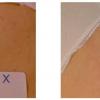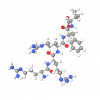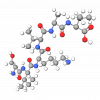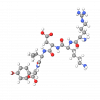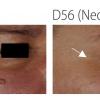Several studies in the 90s showed that on the cellular level stretch marks formation process starts with endogenous glucocorticoid (corticosteroids) secretion under influence of stress or hormonal changes during puberty or pregnancy.
Peptides
There are numerous examples in physiology of peptide regulatory elements that play integral roles in basic homeostatic mechanisms such as injury-repair responses and other stimulus-response actions. Among these are well-known neuropeptides (e.g., bradykinins, endorphins); metabolism and fat storage regulators (e.g., neuropeptide Y, leptin, insulin); tanning and skin pigmentation-related peptides (e.g., α-MSH, ACTH, Agouti), and peptides involved in wound healing (e.g., FGF).
This large group of innovative cosmeceutical ingredients triumphed in the world of skincare products during the last two decades. Peptides are chains of amino acids that are attached in a specific order. Amino acids are naturally occurring in the body and are vital to everyday living processes. Peptides can be made up of 2 or more amino acids that can stimulate different responses within the body. As a result, peptides serve as tiny messengers that can be sent to kick the skin into gear and make it look better.
Peptides are leading a beauty revolution due to their excellent multi-functional properties; formularies are scrambling to access the latest advances in cosmetic peptide technology. In addition, their "Botox-like" performance, activation of collagen and elastin production, and skin-lightening effect make them very efficient against coarse wrinkles and hyperpigmentation of the skin.
In our dermis, the lower structural layer of the skin mainly lies the distinction between youth and senescence. The alteration in such dermal architecture causes the major and most significant visible changes between young and aged skin.
rh-Polypeptide-13, also known under the trade name CG-Noggin (former designation Human Oligopeptide-18; rh-Oligopeptide-18), is a synthetic single-chain recombinant polypeptide that promotes hair growth while inhibiting its depigmentation.
Royal jelly is a mixture containing proteins, sugars, fatty acids, and B vitamins as well as antibacterial and antibiotic agents. In 2011, Japanese scientists discovered that royal jelly's effect on the evolution of bee larvae was due to a protein called Royalactin.
s-Mu-Conotoxin CnIIIC is a synthetic oligopeptide derived from one of marine cone snails' toxins also called conotoxins or conopeptides. μ-CnIIIC is a 22 amino acid length conotoxin polypeptide obtained from Conus consors which exhibited muscle relaxing properties in tests on rodents.
Serilesine® is a peptide-based ingredient with a double anti-aging action on a cellular level. It contains a peptide called Hexapeptide-10, derived from a Laminin part responsible for adhesion. The amino acid sequence of Hexapeptide-10 is Ser-Asp-Gly-Pro-Arg-Pro.
sh-Nonapeptide-4 is a synthetic recombinant peptide known under the trade name Clodessine, a fragment of human Klotho protein that activates different Fibroblasts Growth Fatrors (FGF) and is related to lognitivity. Klotho is considered to be an anti-aging factor.
sh-Oligopeptide-1 is a synthetic analog of human polypeptide EGF (Epidermal Growth Factor), which contains 53 amino acids with the sequence NSDSECPLSHDGYCLHDGVCMYIEALDKYACNCVVGYIGERCQYRDLKWWELR.
sh-Oligopeptide-2 is a synthetic single chain (7.6 kDa) polypeptide hormone structurally similar to proinsulin, an Insulin-like Growth Factor (IGF-1) naturally synthesized in the liver and fibroblast cells.
sh-Oligopeptide-4 is a synthetic recombinant Thymosin-β4 peptide that helps strengthen hair while stimulating hair follicles to produce healthier hair.
sh-Oligopeptide-78 is a synthetic recombinant 20 amino acid long, biomimetic peptide, with a sequence corresponding to a part Type II Keratin, which repeats several times in that structural protein. It is known under the trade name K18Peptide™.
sh-Oligopeptide-85 is a synthetic recombinant peptide, an analog of human Dyskerin involved in stabilizing to RNA molecules and ribosome biogenesis regulation.
sh-Pentapeptide-1 (former designation: Pentapeptide-1) is a synthetic recombinant peptide derived from thymopoietin, a human hormone with immunomodulating properties.
sh-Pentapeptide-5 is a synthetic recombinant peptide that mimics endorphin action and leaves a Botox-like effect. This opioid peptide effectively reduces the appearance of expression lines and deep wrinkles exposing smoother, younger-looking, and healthy skin.
sh-Pentapeptide-6 Trifluoroacetate synthetic recombinant peptide that boosts stratifin protein production improving bio-messaging between skin layers (epidermal-dermal "cross-talk") and leading to dermal remodeling and wrinkle repair.
sh-Polypeptide-1 is a single-chain synthetic peptide (molecular weight 17.25 kDa) hormone bFGF (basic Fibroblast Growth Factor) that regulates skin's renewal promotional subtraction It is also an essential constituent for maintaining the best condition of the body as this is concerned with restor
sh-Polypeptide-10 is a synthetic recombinant single-chain peptide, an analog of human Fibroblast Growth Factor 10 (FGF10) that is involved in normal skin growth, regeneration, and wound repair.
sh-Polypeptide-11 (former rh-Oligopeptide-13; rh-Polypeptide-11) is known under the trade name CG-aFGF, a single-chain synthetic recombinant
sh-Polypeptide-12 is a synthetic recombinant single-chain peptide, an analog of human Interleukin 4 (IL-4), that acts as an antihistamine or immune-suppressor agent to reduce scratching by inhibiting the autoimmune response.
sh-Polypeptide-121 is a synthetic single-chain recombinant peptide derived from human collagen type 21 (also called collagen alpha-1 and encoded by the COL21A1 gene). It is known under the trade name HumaColl™21.
sh-Polypeptide-19 (former rh-Oligopeptide-3) is a synthetic single-chain recombinant peptide, an analog of human TGF-α (Transforming Growth Factor-α). It boosts new dermal cell generation improving skin tone that brimming with vitality & energy.
sh-Polypeptide-2 is a synthetic recombinant analog of human Thioredoxin (TRX) that stimulates dermal cell growth and proliferation and protects them from oxidative stress. Thioredoxin is a natural cytoprotector peptide present in all human cells.
sh-Polypeptide-22 is a synthetic recombinant human transforming growth factor beta 1 (TGFβ-1) analog peptide composed of 113 amino acids.
sh-Polypeptide-28 is a synthetic recombinant human prolactin hormone analog peptide composed of 199 amino acids. Applied topically, prolactin leaves multiple beneficial effects on the skin including:
sh-Polypeptide-3 (former rh-Oligopeptide-5) is a single-chain synthetic recombinant peptide, an analog of human KGF (Keratinocyte Growth Factor). KGF was first described in 1989 as a human growth factor that stimulated epithelial cell proliferation.
sh-Polypeptide-31 is a synthetic recombinant peptide that mimics human Insulin-like Growth Factor-2 (IGF-2). The old designation was rh-Polypeptide-31 (rh- prefix means recombinant human).
sh-Polypeptide-4 is a synthetic analog of human SCF (Stem cell factor), a peptide of 164 amino acids. It is a cytokine that controls the survival, growth, and differentiation of hematopoietic stem cells.
sh-Polypeptide-40 is a synthetic recombinant human placental lactogen (hPL) analog peptide composed of 192 amino acids. hPL is also known as human chorionic somatomammotropin (hCS) or human chorionic somatotropin.
